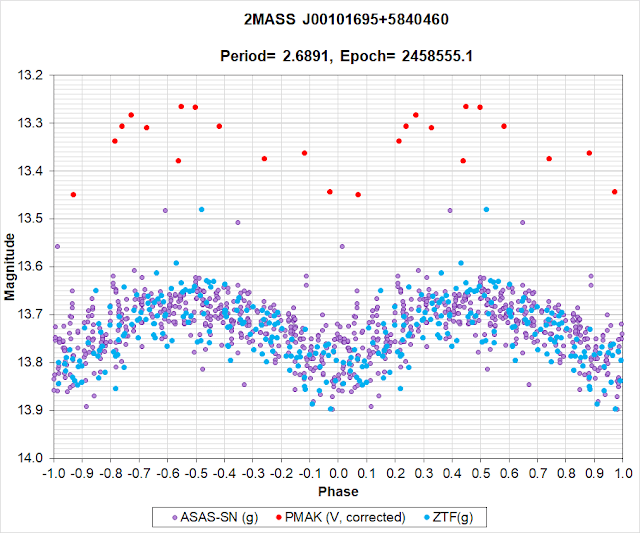Red points in the phase plot are my observations (V band), others are data from ASAS-SN and ZTF surveys (g-band).
Observations have been conducted using Canon EOS 600D camera attached to a 150mm f/5 Newtonian, Muniwin software has been used for searching for new variables.
I should mention that my first assumption of the variability type was RS (also spotted, yet giant stars -- I discovered three of them previously, they had very similar light curves). Thanks to Sebastian Otero, who pointed out that the star has a dwarf luminosity, so it is likely BY.
-----
Переглядаючи кадри, відзняті влітку та восени, знайшов в сузір’ї Кассіопеї, на кутовій відстані приблизно 28 кутових хвилин від змінної MQ Cas (яка була основним об’єктом спостережень) нову змінну типу BY Draconis, яку зареєстрував як PMAK V31 у міжнародній базі змінних (https://aavso.org/vsx/index.php?view=detail.top&oid=1500075)
Ще один тип змінних в моїй колекції!
Змінні типу BY Dra -- зорі, дещо схожі на наше Сонце (тьмяніші), вкриті величезними зоряними плямами, які переважно згруповані в одній півкулі (приблизно так, як на малюнку — художня інтерпретація).
Зоря обертається і, коли на нас дивиться плямистий бік, вона виглядає тьмянішою. Крива блиску схожа на криві затемнюваних зір, однак періоди (інтервали між затемненнями) плямистих зір трохи змінюються з часом (справжні затемнювані змінні строго періодичні), також змінюється амплітуда коливань яскравості. Це пов’язано з еволюцією зоряних плям. PMAK V31 дійсно демонструє невеликі варіації періоду (це видно з аналізу даних автоматичних оглядів неба за різний час).
Ця зоря асоціюється з рентгенівським джерелом 2RXP J001017.3+584051, тобто випромінює помітну кількість рентгену. А це ще одне свідчення “хромосферної активності”, наявності сильних магнітних полів, які призводять до появи зоряних плям.
Спостереження, які привели до знахідки, проводились за допомогою камери Canon EOS 600D та телескопу-рефлектору SkyWatcher 150/750. Пошук змінних на зображеннях здійснювався за допомогою програми Muniwin.
До речі, існує метод оцінки віку сонцеподібних зірок за швидкістю їхнього обертання -- гірохронологія. Грубо кажучи, молоді сонцеподібні зорі мають більше плям і швидше обертаються, а старіші обертаються повільніше і плям на них значно менше [https://www.skyandtelescope.com/astronomy-news/star-spins-show-ages-010820143/] Знання про вік сонцеподібних зір допоможуть створити чітку картину еволюції нашої Галактики.





















